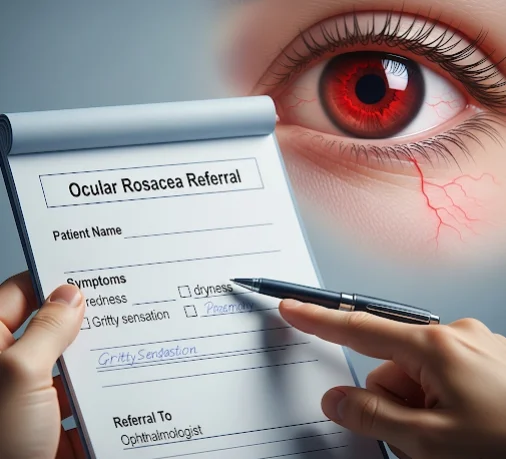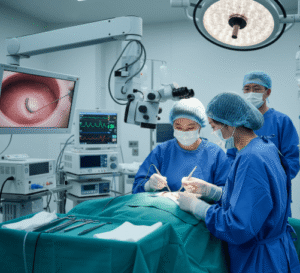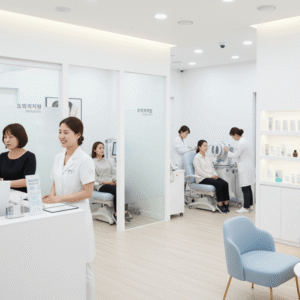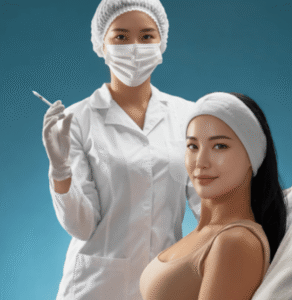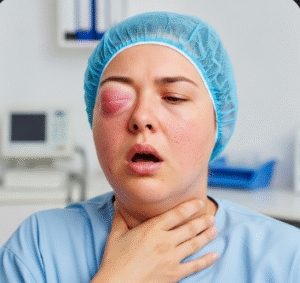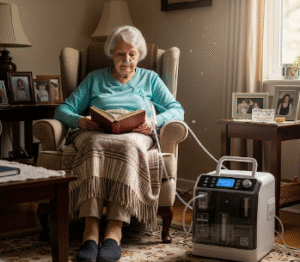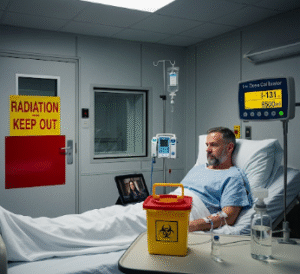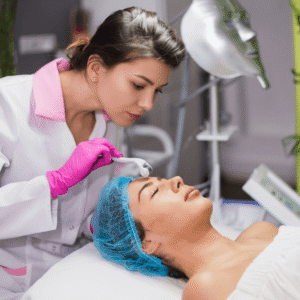What It Is
Defining Ocular Rosacea
→ Ocular rosacea is a subtype of rosacea that affects the eyes and eyelids, often in people who also have facial rosacea.
→ It causes red, irritated, and watery eyes, along with eyelid inflammation, styes, and sensitivity to light.
→ In Korea, patients with ocular rosacea are often referred from dermatologists to ophthalmologists for coordinated care, as the condition requires both skin and eye management.
Key Characteristics
- Redness in eyes (bloodshot appearance)
- Dryness and gritty sensation (feels like sand in the eye)
- Eyelid swelling and irritation
- Styes or chalazia (blocked oil glands)
- Photosensitivity (discomfort in bright light)
- Can lead to serious complications such as corneal damage if untreated
Why It’s Done
Main Reasons for Referral
➡ Specialized Eye Care – Dermatologists treat skin rosacea, but ocular involvement requires an ophthalmologist’s expertise.
➡ Preventing Vision Complications – Untreated ocular rosacea can cause corneal scarring and vision loss.
➡ Targeted Therapy – Ophthalmologists provide eye-specific medications and procedures.
➡ Integrated Care – Many Korean hospitals coordinate dermatology and ophthalmology services for rosacea patients.
➡ Improved Comfort and Appearance – Managing eye redness and swelling improves both health and quality of life.
Alternatives
Non-Medical Options
- Warm Compresses → Applied to eyelids to loosen clogged oil glands.
- Artificial Tears → Reduce dryness and irritation.
- Strict Eyelid Hygiene → Regular cleaning with diluted baby shampoo or eyelid scrubs.
- UV Protection → Sunglasses and hats to reduce light sensitivity.
Medical Alternatives
→ If referral is not immediately possible, dermatologists may initiate care with:
- Topical Antibiotics (Metronidazole, Azelaic Acid) → For facial rosacea, indirectly reducing ocular flares.
- Oral Antibiotics (Doxycycline, Minocycline) → Often prescribed for both skin and ocular inflammation.
- Steroid Eye Drops → Used cautiously and only under ophthalmologist supervision.
- Immunomodulators (Cyclosporine Eye Drops) → Improve lubrication and reduce inflammation.
Preparation
Before Referral and Treatment
➡ Dermatology Evaluation – Skin rosacea patients are checked for eye symptoms.
➡ Patient History – Details about dry eye, styes, blurred vision, or light sensitivity are noted.
➡ Ophthalmology Referral – Patients with suspected ocular involvement are referred promptly.
➡ Medication Review – Doctors review systemic medications already being used (antibiotics, retinoids).
➡ Counseling – Patients are informed that ocular rosacea requires ongoing, long-term care.
How It’s Done
Ocular Rosacea Management in Korea
1. Ophthalmology Examination
→ Patients undergo detailed slit-lamp examination to evaluate eyelids, cornea, and tear film.
- Detects blocked meibomian glands
- Checks for corneal ulcers or scarring
2. Eyelid Hygiene Programs
→ Korean clinics emphasize daily eyelid cleansing routines.
- Warm compresses to loosen gland secretions
- Eyelid scrubs or cleansing pads
- Lid massage techniques
3. Artificial Tears and Lubrication
→ Prescribed to relieve dryness and irritation.
- Preservative-free formulations preferred
- Used several times daily
4. Oral Antibiotics
→ Low-dose doxycycline is a common first-line treatment.
- Reduces inflammation in both skin and eyes
- Taken for weeks to months depending on severity
5. Topical and Prescription Eye Drops
→ Options include:
- Antibiotic eye drops (azithromycin) to control bacterial overgrowth
- Steroid drops (short-term) for severe inflammation
- Cyclosporine (Restasis) for immune modulation and tear improvement
6. In-Clinic Procedures
→ Advanced Korean eye clinics may offer:
- Meibomian gland expression to clear blocked glands
- Intense Pulsed Light (IPL) therapy for eyelid inflammation
- Punctal plugs for tear conservation in severe dry eye
7. Combined Dermatology Care
→ Ocular rosacea care is often paired with skin rosacea treatments.
- Laser therapy for facial redness
- Topical creams for skin lesions
- Patient education about rosacea triggers (heat, spicy food, alcohol, stress)
Recovery
Immediate Recovery
- Patients usually experience eye comfort improvement within weeks of starting therapy.
- Artificial tears and lid hygiene provide fast symptom relief.
- Antibiotics take longer but lead to lasting improvements.
Long-Term Recovery
→ Ocular rosacea is a chronic condition; flare-ups may still occur.
→ With consistent care, symptoms remain under control, and risk of corneal damage is minimized.
→ Lifestyle changes and strict eye hygiene play a crucial role in maintaining remission.
Complications
Possible Risks Without Proper Care
- Corneal Ulcers → Painful lesions that can threaten vision.
- Corneal Scarring → Permanent damage leading to blurred vision.
- Chronic Dry Eye → Persistent discomfort without proper tear management.
- Secondary Infections → From recurrent styes or blepharitis.
- Vision Loss → Rare but possible in severe untreated cases.
Risks of Treatment
- Antibiotic Side Effects → Gastrointestinal upset, photosensitivity.
- Steroid Eye Drops → Risk of cataracts or glaucoma with prolonged use.
- Procedural Risks → Mild discomfort after IPL or gland expression.
Treatment Options in Korea
Advanced Eye and Skin Care Collaboration
South Korea is well-regarded for its integrated medical system, making ocular rosacea care highly coordinated.
Why Korea Excels in Ocular Rosacea Support
➡ Multidisciplinary Clinics – Dermatologists and ophthalmologists work together in university hospitals and private centers.
➡ Cutting-Edge Eye Care – Clinics use advanced diagnostic imaging and meibography for eyelid gland analysis.
➡ Innovative Therapies – IPL, meibomian gland therapies, and biologics are accessible in specialized centers.
➡ Patient-Centered Support – Education and lifestyle modification are integral parts of care programs.
Popular Uses in Korea
- Mild Ocular Rosacea – Managed with lid hygiene and lubricants.
- Moderate Cases – Treated with oral doxycycline and prescription eye drops.
- Severe or Refractory Cases – Require referral to specialist eye hospitals with access to advanced therapies.
- Combined Dermatology + Ophthalmology Care – Patients treated for both facial and ocular rosacea simultaneously.
Patient Experience in Korea
- Referrals are quick and streamlined; dermatologists coordinate with ophthalmology units.
- Appointments are outpatient-based, with minimal downtime for procedures.
- Patients receive step-by-step eye care guidance including home hygiene routines.
- Follow-up visits ensure treatment is adjusted according to progress and flare-ups.
Conclusion
Rosacea ocular referral in Korea ensures that patients receive comprehensive, specialized care for both the skin and eye aspects of rosacea.
Through dermatology-ophthalmology collaboration, Korean clinics provide medical treatment, advanced procedures, and lifestyle support to control symptoms and prevent complications.
For patients struggling with red, dry, and irritated eyes due to rosacea, Korea offers some of the most advanced, integrated, and reliable care systems worldwide, focusing on both long-term eye health and quality of life.

